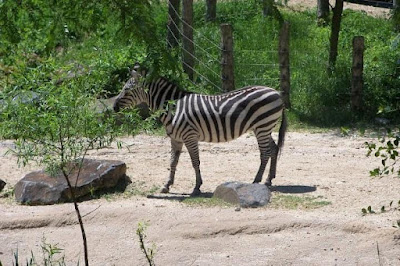Last week, our focus was on expressing gratitude for items and experiences that start with the letter Y. This week, we encourage you to join in by sharing something for which you are thankful that begins with the letter Z. Contributing your thoughts can help promote a collective spirit of appreciation and reflection. Your insights are valuable!
Zebras are fascinating animals that have captured the interest of many due to their unique social behavior and striking black-and-white stripes. These stripes serve various purposes, such as camouflage and social signaling. Reflecting on what brings us gratitude, one might consider aspects of life or objects that also begin with the letter "Z." What are some things you appreciate that start with this particular letter?
🦓 Stripes & Surprises: 8+ Wild Facts About Zebras
They gallop in groups, flash bold patterns, and chat through snorts and whinnies. Zebras are more than just fancy-coated horses! These wild wonders pack personality, power, and puzzling patterns into every hoof step.
Let’s trot into their world!
🎨 1. No Two Zebras Have the Same Stripes
Zebra stripes are like fingerprints; each pattern is one-of-a-kind! Scientists can even recognize individual zebras by their stripes.
🌞 2. Stripes Help Keep Them Cool
It’s not just a fashion statement. Zebra stripes may regulate body temperature. The black and white stripes heat differently, creating air currents that cool the skin. Nature’s air conditioner!
🐘 3. Zebras Are Part of the Horse Family
Zebras belong to the Equidae family, which also includes horses and donkeys. But unlike their cousins, zebras were never domesticated; they’re too wild to saddle!
👁️ 4. Their Eyes Are on the Side of Their Heads
Zebras have side-facing eyes, giving them nearly 360-degree vision, which is perfect for spotting predators on the run.
🦷 5. They Use Their Teeth to Show Emotion
Zebras may bare their teeth to signal greetings, warnings, or mood swings. A grumpy face might mean “back off,” while a wide-open mouth can say “hello!”
🎖️ 6. Zebras Help Honor Veterans
In some community murals and programs, zebras are used to represent courage, resilience, and unity in diversity. Their stripe patterns reflect individuality and the strength of coming together, values that echo the spirit of veterans.
👟 7. They Run Fast—but Not Forever
Zebras can sprint at speeds of up to 40 miles per hour, especially when escaping danger. But they’re built for endurance, not speed bursts; great for traveling across the open plains.
🐾 8. Zebras Communicate with Sounds & Tail Flicks
From high-pitched barks to tail swishes and ear movements, zebras have a full-body language system. They stay connected in herds through these subtle signals.
🌍 Bonus Grazing Bits!
- Mountain zebras have a small dewlap (skin fold) under their necks; no other zebras do!
- Baby zebras are called foals, and they learn their mother’s stripe pattern in just a few days.
- Zebras sleep standing up, and always near others who stand guard!
🌟 Thank You for Joining Me on This Gratitude Alphabet Journey!
From A to Z, we’ve explored a world full of appreciation; one letter, one moment, and one smile at a time. Whether you joined from the beginning or popped in partway through, I’m so grateful you came along.
This journey has been a celebration of kindness, connection, and finding joy in the everyday. Every letter offered a chance to pause, reflect, and recognize the good that surrounds us, even in the smallest things.
Thank you for reading, sharing, and shining with me. Gratitude is more than a word; it’s a ripple. And thanks to you, this alphabet has reached farther than I ever imagined.
Let’s continue to live with open hearts, curious minds, and thankful spirits. 🌈💛
Get your worksheet here:
🦓 Z Is for Zebra: “Stripe by Stripe, I’m Thankful!”
Let kids celebrate individuality and gratitude by designing their own zebras filled with striped patterns representing people, places, and moments that make them feel thankful.
🎨 What You’ll Need:
- Printable zebra outlines or blank paper
- Black and white crayons, markers, or paint
- Optional: colorful stripes to express emotions or use collage materials (ribbons, paper scraps, yarn)
- Gratitude prompt: “What do your stripes stand for?”
🖍️ Activity Instructions:
Part 1: Meet the Zebra
Share a few fun facts:
- Zebras' stripe patterns are as unique as fingerprints!
- They use stripes for camouflage and to confuse predators.
- Zebras often huddle together for protection—there's power in community!
Part 2: Decorate with Meaning
Color the zebra stripes in ways that reflect thankful thoughts.
- A black stripe labeled “My strong big brother”
- A sparkly ribbon stripe for “Laughs with my best friend”
- A rainbow stripe for “Being myself and loved for it”
Add a sentence at the bottom:
“I’m thankful for every stripe that makes me, me.”
Part 3: Zebra Parade Display
Create a classroom “Zebra Crossing of Gratitude” where all the zebras line up with proud stripes and thoughtful reflections.
🧠 Bonus Ideas:
- Write a mini poem titled “My Thankful Stripes”
- Use zebra movement games outside to celebrate how gratitude gives us energy and joy
- Ask: What makes you different that you’re thankful for today?
Books about zebras:
1. Facts About the Zebra by Lisa Strattin
2. How the Zebra Got Its Stripes by Justine Fontes
3. Zebras (Elementary Explorers) by Victoria Blakemore
4. Little Zebra by Julie Abery
Dear parents and caregivers! When it comes to reading time, choose books that are ideal for your little ones. A child-friendly story can ignite imagination and create wonderful moments together! Enjoy reading!
Return to the Alphabet Hub!









No comments:
Post a Comment